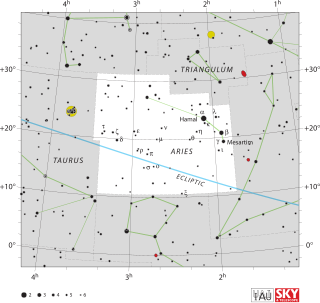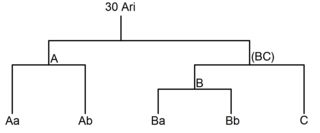
Aries is one of the constellations of the zodiac. It is located in the northern celestial hemisphere between Pisces to the west and Taurus to the east. The name Aries is Latin for ram, and its symbol is , representing a ram's horns. It is one of the 48 constellations described by the 2nd century astronomer Ptolemy, and remains one of the 88 modern constellations. It is a mid-sized constellation, ranking 39th overall size, with an area of 441 square degrees.

Beta Arietis, also named Sheratan, is a star system and the second-brightest star in the constellation of Aries, marking the ram's second horn.

Delta Arietis, also named Botein, is a star in the northern constellation of Aries, 1.8 degrees north of the ecliptic. The apparent visual magnitude is 4.35, so it is visible to the naked eye. It has an annual parallax shift of 19.22 mas; corresponding to a distance of about 170 light-years from the Sun.

Gamma Arietis is a binary star in the northern constellation of Aries. The two components are designated γ¹ Arietis or Gamma Arietis B and γ² Arietis or Gamma Arietis A. The combined apparent visual magnitude of the two stars is 3.86, which is readily visible to the naked eye and makes this the fourth-brightest member of Aries. Based upon parallax measurements obtained during the Hipparcos mission, the distance to Gamma Arietis from the Sun is approximately 164 light-years.

Musca Borealis was a constellation, now discarded, located between the constellations of Aries and Perseus. It was originally called Apes by Petrus Plancius when he created it in 1612. It was made up of a small group of stars, now called 33 Arietis, 35 Arietis, 39 Arietis, and 41 Arietis, in the north of the constellation of Aries.

41 Arietis is a triple star system in the northern constellation of Aries. With an apparent visual magnitude of 3.63, this system is readily visible to the naked eye. It has an annual parallax shift of 19.69 mas, which indicates it is at a distance of 166 light-years from the Sun.
SX Arietis variables are a class of variable stars. They are generally B-type main sequence stars of spectral types B0p to B9p— high-temperature analogues of Alpha2 Canum Venaticorum variables—and exhibit strong magnetic fields and intense He I and Si III spectral lines. They have brightness fluctuations of approximately 0.1 magnitudes with periods of about one day. The prototype of this class is 56 Arietis, which bears the variable star designation SX Arietis.

Zeta Arietis, Latinized from ζ Arietis, is the Bayer designation for a star in the northern constellation of Aries. It is dimly visible to the naked eye with an apparent visual magnitude of +4.89. Based upon an annual parallax shift of 12.44 mas, the distance to this star is 260 ± 20 light-years. This is an A-type main sequence star with a stellar classification of A1 V. It has a high rate of rotation with a projected rotational velocity of 133 km/s. The star is shining at an effective temperature of 9,500 K, giving it the characteristic white-hued glow of an A-type star.

Pi Arietis, Latinized from π Arietis, is the Bayer designation for a multiple star system in the northern constellation of Aries. Based upon parallax measurements made during the Hipparcos mission, this system is approximately 800 light-years distant from Earth and has an apparent visual magnitude of 5.21. This is bright enough to be faintly seen with the naked eye.

Tau1 Arietis, Latinized from τ1 Arietis, is the Bayer designation for a triple star system in the northern constellation of Aries. Based upon an annual parallax shift of 6.41 mas, it is approximately 510 light-years distant from Earth. The combined apparent visual magnitude is 5.27, making it faintly visible to the naked eye.

Tau2 Arietis, Latinized from τ2 Arietis, is the Bayer designation for a binary star in the northern constellation on Aries. The combined apparent visual magnitude of this system is +5.09, which is bright enough to be seen with the naked eye. With an annual parallax shift of 10.27 mas, it is located at a distance of approximately 320 light-years from Earth, give or take a 20 light-year margin of error. At this distance the brightness of the star is diminished by 0.18 in magnitude because of extinction from interstellar gas and dust.
20 Arietis is a star in the northern constellation of Aries. 20 Arietis is the Flamsteed designation. A member of the Hyades open cluster it has an apparent visual magnitude of 5.79, which is bright enough to be just faintly visible to the naked eye. Based upon an annual parallax shift of 23.75 ± 0.33 mas, it is approximately 137 light-years distant from Earth.
56 Arietis is a star in the northern constellation of Aries. 56 Arietis is the Flamsteed designation. It is faintly visible to the naked eye with an apparent visual magnitude is 5.79. The estimated distance to this star is approximately 500 light-years. This is a magnetic, chemically peculiar star of the silicon type and it has a rapid rotation period of 17.5 hours.
59 Arietis is a star in the northern constellation of Aries. 59 Arietis is the Flamsteed designation. It is dimly visible to the naked eye with an apparent visual magnitude of 5.90. Based upon an annual parallax shift of 14.87 ± 0.56 mas, it is approximately 219 light-years distant from the Earth. The spectrum is that of a subgiant star with a stellar classification of G6 IV.
60 Arietis is a star in the northern constellation of Aries. 60 Arietis is the Flamsteed designation. It has an apparent visual magnitude of 6.14. Based upon an annual parallax shift of 10.94 ± 0.53 mas, this star is 298 light-years distant from the Earth. This is a giant star with a stellar classification of K3 III. It has 11 times the radius of the Sun and shines with 39 times the Sun's luminosity. This energy is being radiated from the outer envelope at an effective temperature of 4,365 K, giving it the orange-hued glow of a K-type star.
53 Arietis is a variable star in the northern constellation of Aries. 53 Arietis is the Flamsteed designation; it also bears the variable star designation UW Arietis. It is a B-type main sequence star with a stellar classification of B1.5 V and mean apparent magnitude of 6.10, which is near the lower limit for naked eye visibility. Based upon an annual parallax shift of 3.92 mas, the estimated distance to this star is roughly 800 light-years.

30 Arietis is a 6th-apparent-magnitude quadruple star in the constellation of Aries. 30 Arietis is the Flamsteed designation. 30 Arietis A and B are separated by 38.1" or about 1500 AU at a distance of 130 light years away. The main components of both systems are F-type main-sequence stars, meaning they are fusing hydrogen in their cores. 30 Arietis A is itself a spectroscopic binary with an orbital period of 1.1 days. The 30 Arietis system is 910 million years old, one fifth the age of the Sun.
Interpretation of Schizophrenia is a book by Italy-born American psychiatrist Silvano Arieti in which the author sets forth demonstrative evidence of a psychological etiology for schizophrenia.
23 Arietis is a star in the constellation of Aries. 23 Arietis is the Flamsteed designation. Its apparent magnitude is 6.83.
50 Arietis is a star in the constellation of Aries. 50 Arietis is the Flamsteed designation. Its apparent magnitude is 6.80.





